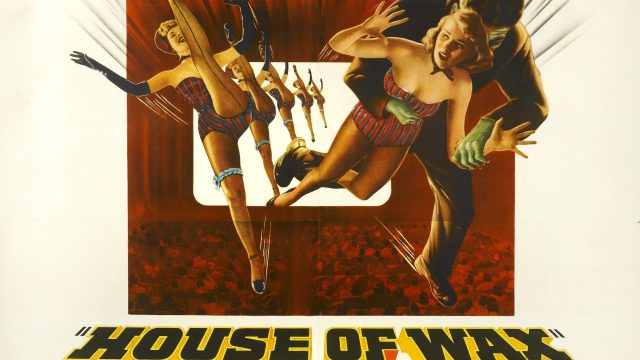Everyone knows that Vincent Price is a horror legend. If the decision were made to scrub those dead presidents off Mount Rushmore and put up a bunch of legendary horror movie stars instead — long overdue, in my opinion — then Price would absolutely be up there, most likely alongside Peter Cushing, Christopher Lee and a special rotating fourth head that would give Boris Karloff and Bela Lugosi equal mountain time. But for the first fifteen years of Price’s Hollywood career, that wasn’t the case — he appeared in supporting roles in noir, period dramas and comedies. By the early ’50s, he was considering giving up movies and returning to the stage, disillusioned by the roles he was being offered and the grim state of the industry at that time, with the McCarthy era at its height and many of his friends and peers impacted by the investigations and blacklist.
House of Wax, a remake of Michael Curtiz’ Mystery of the Wax Museum (previously covered here by some dashing and handsome writer) was conceived to take advantage of the new 3D technology that had debuted with the previous year’s Bwana Devil, an unexpected hit that had studios scrabbling for ideas to capitalize on a potential new craze. Bizarrely, the director chosen for this project was André DeToth, who only had one eye and was therefore incapable of actually experiencing the effect — something which seems ridiculous in hindsight, but may have actually contributed to the enduring quality of the film. After all, who better to ensure a 3D movie doesn’t lean too hard on the gimmick than a man who can’t actually see it?
That’s not to say that it doesn’t have a few classic gimmick scenes — most notably, there’s an extended sequence of a man promoting the wax museum by performing paddle-board tricks, cheerfully breaking the fourth wall as he threatens to knock the popcorn out of an audience member’s hands. But for the most part DeToth uses the 3D with restraint, adding some genuinely wonderful depth to the shadowy scenes of our heroine Sue (Phyllis Kirk) being stalked through the streets or the museum after dark, and leading to some inventive scares as characters loom out of the shadows (notably Price’s deaf-mute pupil/henchman Igor, played by a young Charles Bronson!) The 3D is so well-done, in fact, that apparently Martin Scorsese called it the best-ever use of the technology, and screened it to his crew as an example of how to do it right, while making Hugo.
In terms of plot, House of Wax streamlines the earlier movie into a far more effective horror story, even if it loses some of the crackling screwball dialogue. Price, of course, plays the talented but strange sculptor who talks to his own work. He makes the eccentricities endearing in the early scenes, then twists them just slightly to perfectly convey the shift in his character after his corrupt business partner torches the original museum, leaving him for dead. The rise of the new museum — now fully equipped with a Chamber of Horrors — coincides with a mysterious string of murders. But surely they couldn’t be related…could they?
Glenda Farrell runs away with the earlier version of this story, her plucky newspaperwoman heroine stealing hearts both onscreen and off (and by “hearts,” I mean mine). But the remake is all about Price, not exactly playing a full-on villain but a man broken by betrayal and pushed into desperate actions. He does such a good job remaining sympathetic (or at least pitiable) despite the mounting body count that it’s no wonder this became the pivot point for his career. Prior to this, the only real horror movie he’d starred in was a (really fun) Invisible Man sequel, but after this he did little else. He seems to have delighted in the success of this particular movie and the revival of his career — apparently at its peak, he would attend screenings and whisper “did you enjoy that?” to unsuspecting patrons as the film ended, adding one final scare (and a bit of additional 3D) to their ticket price.
The 3D craze didn’t last much longer — the difficulties in screening the films (this 88-minute movie has an intermission because of the issues in syncing up the reels for two separate projectors) and a few high-profile flops made studios pretty much abandon the concept within a year or two, until new advances led to a second wave of 3D almost 30 years later. But Vincent Price’s new status as a horror legend lasted the rest of his career, and this isn’t just the launching point — it’s also one of his best, in my eyes. The writing might not be quite as sharp as the ’30s version (see the clunky misogynist banter between the cops for an example; the movie doesn’t seem to be taking their side, at least), but it’s superbly paced and thrilling, with some great FX and makeup. And damn, does it ever look cool in 3D.

